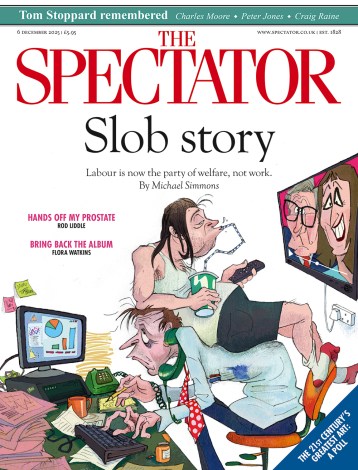
The cover painting for The Specialist, a new podcast from Sotheby’s, looks like a scene from Mad Men. The people are so good-looking and so well dressed that you barely notice how odd they are. One chap’s walking along with a porcelain bowl as if it were a macchiato; a lady holds a plant in her palms in the manner of receiving communion; someone else walks the street with a gavel. The admen have done their job: intrigued, I press play.
It becomes apparent that the people who work at Sotheby’s have no interest in persuading anyone that they are normal. I listen to Ottilie, Julian and Gregory, and to mouths that volunteer, with ease, such phrases as ‘the visceral power is undimmed by the passage of time’. Voices grow more animated at the discovery of pentimenti, particulars of provenance and the prospect of record-breaking sales. Like estate agents for HNWIs, only clever, the specialists make no effort to pretend their world is something it isn’t. I applaud their honesty.
There are two main types of episode. The first, released as a batch last month, is longer and more conversational. Simon Schama and curator Eleanor Nairne discuss portraiture and actress Julianne Moore gives a collector’s view on 20th-century design. Most of these episodes were taken from recordings of live events. A week after this delivery came the start of what feels like another series entirely. Each episode averages 11 minutes and features one Sotheby’s expert speaking directly to us about the sale of a single artwork. I have worked my way through most of the short ones and duly crown The Specialist my podcast of the summer.
It’s remarkable what you can learn in 11 minutes. Simon Shaw speaks wonderfully – and at auction-speed – of the record set by the 2012 sale of Munch’s ‘The Scream’. There were only ever four versions of the work, two of which have been stolen, and only one privately held. The production of prints kick-started the fascination with the image, which is apparently alone among paintings for inspiring not one emoji, but two (you may not yet have discovered the screaming cat).
The £16.25 million realised by the sale of a Vermeer were a bonus to the achievement of the painting’s attribution. I had no idea there were just 36 recognised Vermeer paintings. The prospect of adding to the catalogue was complicated by the fact that the artist has so often been forged. Even a painting sold to Göring on behalf of Hitler was revealed as a fake. Listen to the episode on Kandinsky for a moving story of art restitution. A painting by the Bauhaus master had hung in the dining room of a family that had tried to flee the Nazis. Its rediscovery, many years after its sale under duress, was quite miraculous.
Should all this put you in the mood for more art, ensure you listen to Your Places or Mine first. Clive Aslet, the architectural writer and visiting Cambridge professor, and John Goodall, architectural editor for Country Life, have been running their fascinating weekly podcast since the early summer, delving into many a museum and historic house.
The people who work at Sotheby’s have no interest in persuading anyone that they are normal
They recently assessed the changes to the National Gallery, which, incidentally, has an enjoyable new podcast of its own, Stories in Colour. Aslet and Goodall admire William Wilkins’s original gallery building (apart from the ‘clunky’ dome) but save their enthusiasm for the latest additions by Selldorf Architects. I confess, I hadn’t noticed many of the features they praise, including the removal or slimming down of some of the ‘Teletubby’ columns in the entrance to the Sainsbury Wing, and an area of rustication that Goodall describes, in his jovial tones, as ‘really, really satisfying’.
As with The Specialist, this podcast is most likely to appeal to listeners with ears attuned to long vowels and guffaws, and for whom ‘rustication’ is familiar terminology. Which is to say the readers of this magazine. Aslet and Goodall will digress in order to explain (‘I suppose we’d better say something about Wilkins…’) but rightly feel no compulsion to dumb-down. They often seem to forget that the tape is rolling, so at ease are they in each other’s company.
‘You’ve got to pity these people,’ remarks Aslet of 19th-century aristocrats who sought American wives to replenish their coffers and restock their art collections. ‘They hadn’t been brought up to do anything except serve in the army… many had been to Eton so could talk very well about things, but…’ Cue an endearing guffaw from Goodall, who sounds forever to be on the verge of hysterics. Art: a serious business, except when it’s not.








Comments